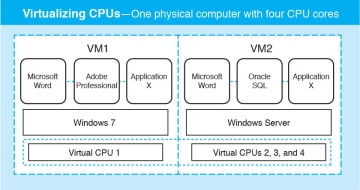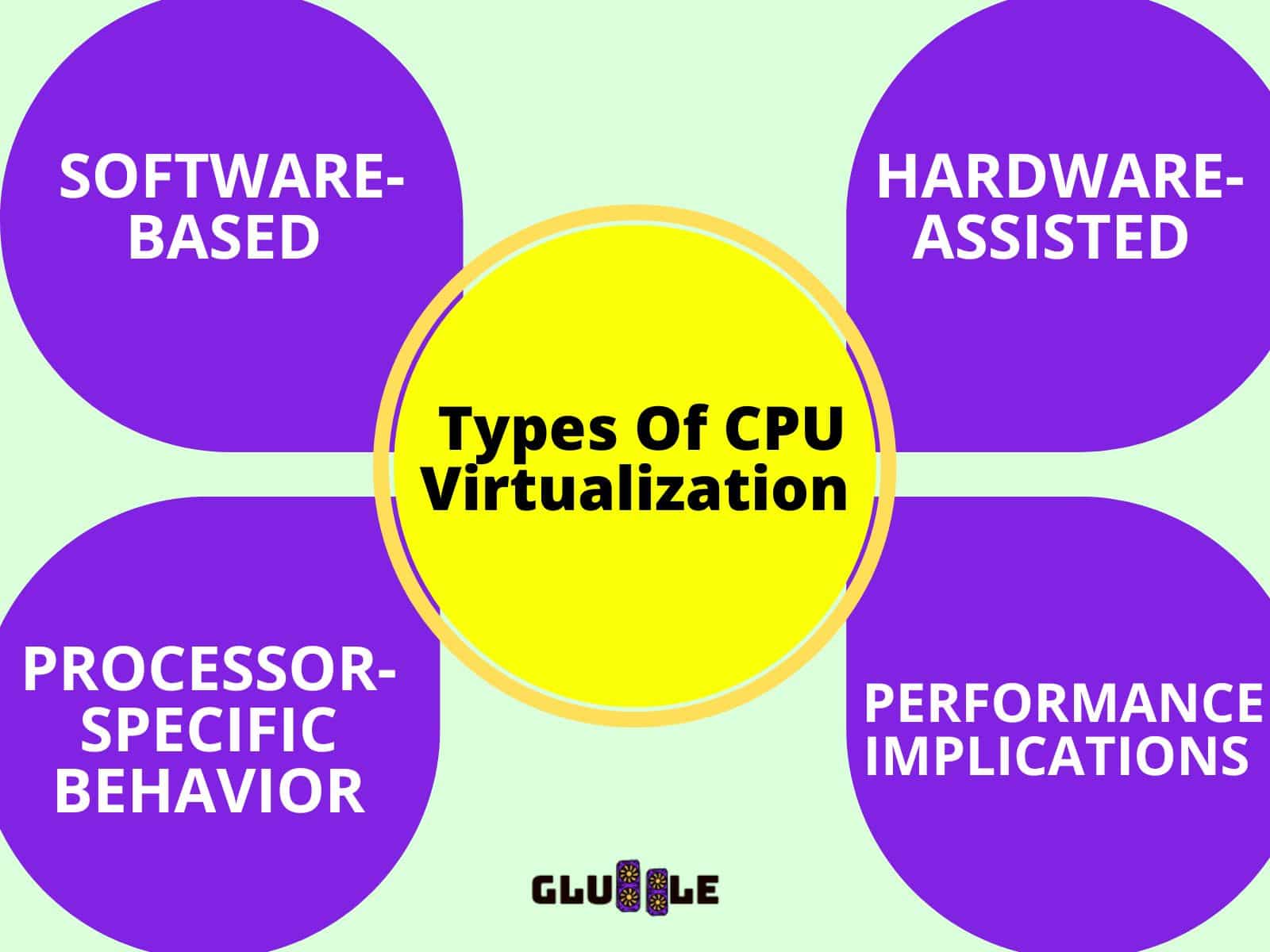CPU virtualization is an advanced technology that allows one physical CPU to do the work of multiple virtual CPUs. This technology is getting more and more popular because it can make the most of server resources and make things run more smoothly. CPU virtualization technology is the process of making a virtual, software-based copy of a real computer system. It includes the hardware parts like the CPU, memory, storage, and networking.
This technology allows multiple operating systems and applications to run on a single physical workstation at the same time. In this blog post, I’m going to reveal what CPU virtualization technology is, how it works, and why it is beneficial for businesses. Therefore, keep reading until the last to become a pro of CPU virtualization technology.
What Is CPU Virtualization?

CPU virtualization is a technology that allows multiple operating systems to run on a single CPU. This technology has become popular in recent years. It allows for more efficient usage of resources and makes the process of managing multiple operating systems easier.
With CPU virtualization, a single physical machine with one or more CPUs can be used to host multiple virtual machines. Each of which runs its own operating system.
Difference Between Virtualization and Emulation
The main difference between virtualization and emulation is that virtualization allows multiple operating systems to run on a single physical machine, while emulation is used to run software designed for one system on a different system.
Virtualization is more efficient than emulation because it lets multiple virtual machines share the same hardware resources. Emulation, on the other hand, needs more resources to create a virtual environment that works like the original hardware.
In general, virtualization is better for consolidating servers, while emulation is more often used for testing and developing software.
How does CPU virtualization work?
At its core, CPU virtualization works by providing a layer between the hardware and the operating system. This layer is in charge of translating the commands from the operating system into instructions that the processor can understand. As a result, even though multiple virtual machines share the same hardware, each operating system can function as if it had exclusive access to it.

Organizations can get the most out of their physical machines and manage their physical resources well by using CPU virtualization technology. This technology makes it easy to run multiple operating systems on a single CPU. Users can use the power of virtual processors without sacrificing performance because of this.
Related Reading:
- How To Enable Virtualization In Bios MSI B550m A Pro Max?
- How To Enable/Disable AMD virtualization in BIOS?
- How To Enable Virtualization In Bios MSI [2023]
The Different Types Of CPU Virtualization (Hardware Assisted, Software-Based)
CPU virtualization technology is a form of virtualization technology that allows a single CPU to function as if it were multiple virtual CPUs. This technology is used in virtualization software.

It lets multiple operating systems and applications run at the same time on a single CPU, which makes a single physical machine work as efficiently as possible. CPU virtualization comes in four different forms: software-based, hardware-assisted, virtualization, and processor-specific behavior, as well as the effects of CPU virtualization on performance.
Here are different types of CPU virtualization:
Software-Based Virtualization
Software-based virtualization is a type of CPU virtualization that utilizes software instead of hardware. Using virtualization software, it lets a single CPU work as if it were several virtual CPUs. Most of the time, this type of CPU virtualization is used to turn a single physical machine into several virtual machines (VMs). Intel Virtualization Technology (Intel VT) is an example of this type of virtualization.
Hardware-assisted Virtualization
Hardware-assisted virtualization is a type of CPU virtualization that lets you run more than one operating system on a single CPU by using special hardware. Intel VT-x is an example of this type of technology. It works with some Intel CPUs and makes the best use of their resources by letting multiple operating systems and applications run at the same time on a single CPU.
Virtualization and Processor-Specific Behavior
Virtualization and processor-specific behavior is another type of CPU virtualization. It emphasizes on the fact that different CPUs behave differently when dealing with virtual processors or VMs. This means that it’s important to understand the behavior of the specific CPU that is being used when considering CPU virtualization.
Performance Implications of CPU Virtualization
Performance implications of CPU virtualization is the fourth type of CPU virtualization technology. This kind of virtualization takes into account how running multiple operating systems and applications on a single CPU affects performance. When thinking about this kind of CPU virtualization, it’s important to think about things like how much RAM is available, how fast the CPU is, and other performance metrics.
The challenges of CPU Virtualization
CPU virtualization is a powerful tool, but it does come with some drawbacks. It is not always easy to implement and may require considerable effort from administrators.
Here are some challenges of CPU Virtualization
1. Extra Work
One of the biggest problems with CPU virtualization is that running multiple operating systems on a single CPU adds extra work. For example, Intel Virtualization Technology must be turned on when an Intel CPU is used to run more than one virtual machine. This technology focuses on performance. But it also needs more computing power, which can slow down the physical machine’s overall performance.
2. Special Software & Their Update
CPU virtualization needs special software to manage the virtual processors and the physical resources they use. This virtualization software needs to be updated regularly to make sure that all the virtual processors work well and safely.
3. Makes System More Complicated
CPU virtualization can make the system more flexible and scalable, but it can also make the system more complicated. For administrators to run a system with CPU virtualization well, they need to know a lot about the software and hardware involved.
Overall, CPU virtualization is an impressive technology, but it presents some unique challenges. With the right approach and tools, however, businesses can use this technology to maximize their computing power. As well as take advantage of the added flexibility that comes with virtualization.
Related Reading:
- How To Fix Graphic Card Over Heating?
- How do external graphic cards work? And why are they important?
- How To Check GPU Usage in Windows and MacOS?
The Importance of CPU Virtualization
CPU virtualization technology is becoming increasingly important in the modern world of computing. It allows multiple operating systems, applications and services to be installed on a single CPU or even multiple CPUs. This means that organizations can more easily scale up and down their computing resources to meet their changing needs.
CPU virtualization emphasizes performance and runs using physical resources by making a virtual machine that acts like a real machine and has its own set of virtual processors, memory, storage, and other hardware. With this technology, the same hardware can run multiple applications, operating systems, and virtual machines.
Intel Virtualization Technology (Intel VT) is one example of how CPU virtualization technology is used today. Intel VT lets virtualization software run multiple operating systems and applications on a single Intel CPU by using Intel CPUs. It also helps ensure data security by isolating each operating system from the others.
CPU virtualization also helps bring down overall costs because it lets organizations use their existing hardware instead of buying more to meet their needs. Also, it helps improve efficiency by letting the same physical machine handle multiple workloads.
In short, CPU virtualization technology can make an organization’s computers much faster and more efficient while lowering costs. It is an essential technology for any organization looking to make the most out of their physical resources.
Conclusion
In conclusion, virtualization technology enables multiple virtual machines to share the same physical hardware, allowing you to run many virtual CPUs simultaneously. The underlying processor runs faster since there is no need for binary translation, reducing the amount of overhead.
Each virtual machine runs in guest mode. It accepts the same data or inputs and achieves the same results as if they were running on a single-processor or dual-processor machine.
Virtualization technology also offers resource allocation and security features. It makes it a common reason for using virtual machines so each virtual machine can share a common virtual environment. With advancements such as virtual machine extensions, it is becoming easier to utilize virtualization technology for a wide variety of applications.
